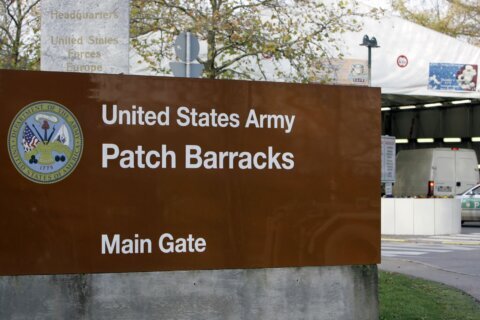In WTOP’s three-part series “City of Secrets,” WTOP National Security Correspondent J.J. Green talks to some of the best in the espionage game to find how spies have infiltrated Washington, D.C., and what can be done to catch them.
Nothing stood out about her.
She lived in a modest two-bedroom cooperative apartment on a quiet tree-lined street in D.C.’s Cleveland Park neighborhood. She drove a red 2000 Toyota Echo. She banked at Riggs Bank in the District’s Friendship Heights section. She was bright, engaging, trusted and well-adjusted at work.
But she was also something else.
Ana Belen Montes, 44, was a spy — engaged in one of the most devastating espionage operations in the history of the United States.
She was arrested on Sept. 21, 2001, and charged with conspiracy to deliver U.S. national defense information to Cuba.
Her arrest dealt a blow to the U.S. government, because she was a senior-level analyst at the Defense Intelligence Agency (DIA).
Her cover worked perfectly until, according to FBI documents, “an astute DIA colleague — acting on a gut feeling — reported to a security official that he felt Montes might be under the influence of Cuban intelligence.”
Scott Carmichael, now a former senior security and counterintelligence investigator for the Defense Intelligence Agency, was that “astute colleague.”
Another colleague who had suspicions was Chris Simmons, former chief of the Americas team with DIA’s counterintelligence research unit.
“There were gatherings in D.C. at various academic forums where Cuban intelligence officers would show up to do presentations, and she and other DIA employees went there. But they were warned by security to stop attending because ‘you’re at risk,’” Simmons said.
All the others stopped attending, he said, “but she refused.”
SIGN UP TODAY for J.J. Green’s new national security newsletter, “Inside the SCIF.” The weekly email delivers unique insight into the intelligence, national security, military, law enforcement and foreign policy communities.
It wasn’t until she received an ultimatum, according to Simmons — “stop attending or get fired” — that she ceased going to the events.
Montes was so skilled at spying that during her years at DIA, even though security officials learned about her foreign policy views and were concerned about her access to sensitive information, they had no concrete reason to believe she was sharing secrets. Besides, she had passed a polygraph.

In her 15-year career at DIA, she had acquired a top-level security clearance and become DIA’s top Cuban analyst. And she was known throughout the U.S. intelligence community for her expertise.
Montes was in possession of extremely sensitive information — which it turned out she was giving to her Cuban handlers when they’d meet at various restaurants near D.C. Metro stops.
After a long investigation, authorities determined she was a spy and figured out how she’d been turned.
“A classic tale of recruitment” is how official court documents in 2001 describe what happened.
In 1984, Montes worked in a clerical job at the Department of Justice in D.C. “She often,” according to one document, “spoke openly against the U.S. government’s policies towards Central America. Soon, her opinions caught the attention of Cuban ‘officials’ who thought she’d be sympathetic to their cause.”
According to the FBI, she met with them and “soon after, Montes agreed to help Cuba.”
In order to do that, she sought out a job in the U.S. intelligence community and applied at DIA, an important producer of intelligence for the Pentagon. According to the court documents, by the time she started work there in 1985, “she was a fully recruited spy.”
“To escape detection, Montes never removed any documents from work, electronically or in hard copy,” said the documents.
“Instead,” Simmons said, “she memorized the details and went home and typed them out on her laptop.”
The court documents also indicate that she transferred the information onto encrypted disks. After receiving instructions from the Cubans in code via short-wave radio, she’d meet with her handler and turn over the disks.
Montes, serving a 25 year sentence, is scheduled to be released in 2023.
Her case was just one of many international spy stories that have unfolded in the D.C. area, and each is unique.
Another involved Kevin Mallory, a former CIA case officer who was recently sentenced to 20 years in prison on espionage charges.
“Mr. Mallory decided that five years after retirement, he needed to make extra money. He made his services available to the Chinese. We caught him. He was convicted of espionage and sentenced,” said Brian Dugan, assistant special agent in charge of counterintelligence at the FBI’s D.C. field office.
What’s unique about Mallory’s case was the speed with which it was handled.
“It was actually a short case. Usually espionage cases take years. But in that specific case, it took months,” Dugan said.
Technology and possibly carelessness contributed to the speedy resolution.
“Gone are the days of meeting handlers once in a while, to where we have Mallory talking on a regular basis to his handlers electronically in what he thought were hidden conversations. We were able to catch that and move on that quicker,” Dugan said.
But in another way, Mallory’s case was not unique.
He was well liked in his Leesburg, Virginia, community, known for helping neighbors in their yards and assisting immigrants with their taxes, and he was a regular at church — all attributes that numerous past U.S. spies have exhibited.
Those attributes are also classic covers that spies often use to avoid suspicion.








